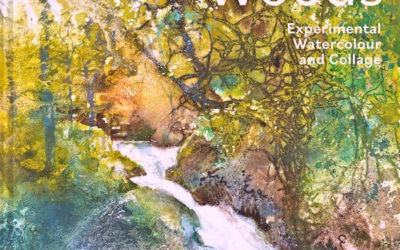I have recently been lucky enough to become a member of a group called the Arborealists who are passionate about nature and in particular trees. Each artist in the group uses a different style or medium and the work varies from tiny to huge- There were watercolours of at least a couple of metres long in a recent exhibition and there are also wonderful etchings, oils, prints of trees made on handmade paper using leaves from the same tree, huge draped, dangling installations of abstract work on paper made by a collaboration of artists and much more. It is really exciting .
What is also very inspiring is the number of projects that are being lined up throughout UK and in France too. I joined the group just in time to be involved with a project that will culminate in an exhibition in Uk next year. There is a secret wood that has been unmanaged for many years as an ecological experiment and barely any humans have entered it for decades. The group have been given permission to visit the woodland to gather information, paint and draw and the resulting works will be exhibited. We paid a spring visit to the wood recently and will return in the autumn. It will be interesting to see how the atmosphere changes with the different plants and cycles of vegetation, the differing colours and weather of a new season. This theme is endlessly fascinating to me.
When we visited in April the wood was a shimmering haze of tender greens, flecks and speckles. White stars of wild garlic shone out from the earthy floor and ferns with their shuttlecock feathered leaf patterns sat snugly among last year’s crunchy bronzed leaves . I sat under a group of ancient yew trees to paint the textured bark and twisting shapes of the trunks. It felt like a dark oasis of earth and shadow under the evergreen trees. Through the gaps I could see the delicate filigree and sparkle of the sunlit foliage in the more open woodland beyond.
As I made my sketches I began to feel that perhaps what I had chosen as a subject did not best capture the overall atmosphere of the wood . I had spent a long time earlier wandering through the varied tangled treescapes looking, listening to birdsong, smelling the scent of the wild garlic,looking again, soaking up the feel of the place before settling. I remembered the words of my late father in one of his books*:’ I like to settle quickly wherever I happen to be and see what I can make of the material immediately available, looking at in terms of interesting patterns.” It saves endless time spent walking around looking for the paintable subject.’ Sound advice as it is not what the subject is but how we interpret it that can make it interesting. I noticed one of the other artists had immediately settled in front of some shrubs that to me looked uninspiring and noted how she stayed there for the whole two days , painting it in detail. Perhaps I should have chosen something earlier? Maybe I should be painting, not sketching? In fact , what I had been drawing was probably complete rubbish in comparison to her amazing work! I realised that I could go two ways with these thoughts. I could either learn from them and act accordingly or allow all my insecurities and doubts creep in. I decided that the lesson I would take from this was to be more confident about my decisions because it was how I interpreted the subject that mattered. My paintings are not ‘of’ the woodland’ but ‘about’ it and the arguably ‘wasted’ time spent gazing and absorbing the sense of the place was actually crucial to my way of working, as it becomes more towards abstract and less about representation.
I found it fascinating and sometimes worrying over the weekend to get a glimpse into the way other artists work and discovered a few things about myself. I decided not to allow other artist’s creative decisions feed my negative self doubts but let the experience strengthen my sense of being ‘me’ . Creativity is not hierarchic. There isn’t a ‘best’ way to do things. Whatever I or any of us decide to do artistically can be unique and valid.
* ‘Watercolour -Practise and progress’ by G. John Blockley published in 1985 by A&C Black ( out of print)
——————————————————————————————————————————————————————————————————————




